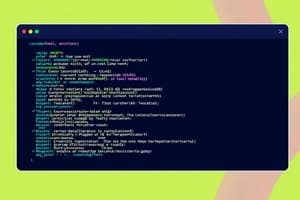Podcast
Questions and Answers
Which statement accurately describes the role of HTML in web development?
Which statement accurately describes the role of HTML in web development?
- HTML is used to manage server-side operations and databases.
- HTML is responsible for defining the structure and content of a webpage. (correct)
- HTML is a programming language used to create dynamic web applications.
- HTML is primarily used for styling the visual appearance of a webpage.
What is the correct syntax for declaring the document type in HTML5?
What is the correct syntax for declaring the document type in HTML5?
- <!DOCTYPE HTML>
- <DOCTYPE html>
- <!DOCTYPE html> (correct)
- <HTML DOCTYPE>
Which HTML element is used to define the main content of an HTML document?
Which HTML element is used to define the main content of an HTML document?
- <title>
- <head>
- <html>
- <body> (correct)
What is the term for an HTML element that contains both a start tag and an end tag?
What is the term for an HTML element that contains both a start tag and an end tag?
Which of the following is an example of a correctly nested HTML structure?
Which of the following is an example of a correctly nested HTML structure?
What is the purpose of HTML attributes?
What is the purpose of HTML attributes?
Which of the following HTML elements is considered an 'empty' element?
Which of the following HTML elements is considered an 'empty' element?
Suppose you want to display the text 5 > 3 in an HTML document. What is the correct HTML to use so that the browser renders the > symbol correctly?
Suppose you want to display the text 5 > 3 in an HTML document. What is the correct HTML to use so that the browser renders the > symbol correctly?
Consider an HTML document with improperly nested tags: <p><b>This is a test</p></b>. How might a browser handle this?
Consider an HTML document with improperly nested tags: <p><b>This is a test</p></b>. How might a browser handle this?
Given the following HTML snippet: <body><div><h1>Hello</h1></div><p>World</p></body>. If a CSS rule body > * { margin: 10px; } is applied, what elements will have a 10px margin?
Given the following HTML snippet: <body><div><h1>Hello</h1></div><p>World</p></body>. If a CSS rule body > * { margin: 10px; } is applied, what elements will have a 10px margin?
Which of the following statements accurately describes HTML attributes?
Which of the following statements accurately describes HTML attributes?
What attribute is mandatory within the <a> tag to create a hyperlink to another webpage?
What attribute is mandatory within the <a> tag to create a hyperlink to another webpage?
Which of the options represents a block-level element?
Which of the options represents a block-level element?
Which HTML tag is used to define the most important heading?
Which HTML tag is used to define the most important heading?
What is the primary function of the HTML <blockquote> element?
What is the primary function of the HTML <blockquote> element?
How do inline elements differ from block-level elements in HTML?
How do inline elements differ from block-level elements in HTML?
Consider the following HTML snippet: <a href="https://example.com"><img src="image.png"></a>. If a user clicks on the image, what will happen?
Consider the following HTML snippet: <a href="https://example.com"><img src="image.png"></a>. If a user clicks on the image, what will happen?
Given the following HTML structure: <div><p>This is a paragraph with a <span>span element</span> inside.</p></div>, which of the following statements is most accurate?
Given the following HTML structure: <div><p>This is a paragraph with a <span>span element</span> inside.</p></div>, which of the following statements is most accurate?
In HTML, every element has a default display value. What determines this default display value?
In HTML, every element has a default display value. What determines this default display value?
Consider a scenario where you want to embed an image that also acts as a link. However, you want the image to open in a new tab when clicked. Which of the options will achieve this?
Consider a scenario where you want to embed an image that also acts as a link. However, you want the image to open in a new tab when clicked. Which of the options will achieve this?
HTML attributes provide additional information about HTML elements.
HTML attributes provide additional information about HTML elements.
HTML attributes are specified in the closing tag of an element.
HTML attributes are specified in the closing tag of an element.
The href attribute within the <a> tag specifies the text that will be displayed as the hyperlink.
The href attribute within the <a> tag specifies the text that will be displayed as the hyperlink.
The <img> tag requires both width and height attributes to ensure proper image display and prevent layout shifting.
The <img> tag requires both width and height attributes to ensure proper image display and prevent layout shifting.
A block-level element, by default, flows within the surrounding content without starting on a new line.
A block-level element, by default, flows within the surrounding content without starting on a new line.
Inline elements, like <span>, automatically add a margin before and after themselves.
Inline elements, like <span>, automatically add a margin before and after themselves.
The <h1> tag represents the least important heading on a webpage.
The <h1> tag represents the least important heading on a webpage.
HTML paragraphs, defined by the <p> tag, are displayed without automatic line breaks.
HTML paragraphs, defined by the <p> tag, are displayed without automatic line breaks.
The <abbr> element is exclusively used to define sections quoted from external sources.
The <abbr> element is exclusively used to define sections quoted from external sources.
An HTML <a> tag can be used to create hyperlinks to other websites, files, locations within the same page, email addresses, or any other URL.
An HTML <a> tag can be used to create hyperlinks to other websites, files, locations within the same page, email addresses, or any other URL.
HTML is employed to dictate the arrangement of web pages.
HTML is employed to dictate the arrangement of web pages.
HTML documents require a declaration that begins with <!DOCTYPE html>.
HTML documents require a declaration that begins with <!DOCTYPE html>.
An HTML element is delineated exclusively by a start tag.
An HTML element is delineated exclusively by a start tag.
Empty HTML elements, like the <br> tag, require a closing tag.
Empty HTML elements, like the <br> tag, require a closing tag.
Nesting HTML elements is prohibited, as it complicates the document structure.
Nesting HTML elements is prohibited, as it complicates the document structure.
The <body> element is a child of the <head> element.
The <body> element is a child of the <head> element.
HTML attributes provide mandatory information about HTML elements.
HTML attributes provide mandatory information about HTML elements.
The phrase element <strong> is semantically identical to the phrase element <em>, only differing in browser display defaults.
The phrase element <strong> is semantically identical to the phrase element <em>, only differing in browser display defaults.
The HTML entity represents a non-breaking space, which is visually identical to a standard space but prevents line breaks at its location.
The HTML entity represents a non-breaking space, which is visually identical to a standard space but prevents line breaks at its location.
In valid HTML5, the following declaration will render in quirks mode in all browsers: <!DOCTYPE HTML SYSTEM "http://www.w3.org/TR/html4/strict.dtd">
In valid HTML5, the following declaration will render in quirks mode in all browsers: <!DOCTYPE HTML SYSTEM "http://www.w3.org/TR/html4/strict.dtd">
Flashcards
What is HTML?
What is HTML?
Hyper Text Markup Language, the standard language for creating web pages. It describes the structure of a web page using elements.
HTML element purpose
HTML element purpose
HTML elements tell the browser how to display content. They label pieces of content like headings, paragraphs, and links.
HTML element
HTML element
An HTML element consists of a start tag, content, and an end tag. For example: Content
Nested HTML elements
Nested HTML elements
Signup and view all the flashcards
Root element
Root element
Signup and view all the flashcards
HTML attributes
HTML attributes
Signup and view all the flashcards
DOCTYPE declaration
DOCTYPE declaration
Signup and view all the flashcards
and tags
and tags
Signup and view all the flashcards
and tags
and tags
Signup and view all the flashcards
Empty elements
Empty elements
Signup and view all the flashcards
Signup and view all the flashcards
Block-level elements
Block-level elements
Signup and view all the flashcards
Inline elements
Inline elements
Signup and view all the flashcards
and
Signup and view all the flashcards
and
Signup and view all the flashcards
HTML Headings
HTML Headings
Signup and view all the flashcards
tag
tag
Signup and view all the flashcards
tag
tag
Signup and view all the flashcards
Signup and view all the flashcards
![]() width and height attributes
width and height attributes
width and height attributes
Signup and view all the flashcards
Markup Language
Markup Language
Signup and view all the flashcards
Web Browsers
Web Browsers
Signup and view all the flashcards
HTML Documents
HTML Documents
Signup and view all the flashcards
HTML Paragraph
HTML Paragraph
Signup and view all the flashcards
HTML Quotation
HTML Quotation
Signup and view all the flashcards
HTML Links
HTML Links
Signup and view all the flashcards
Signup and view all the flashcards
and
elements
Signup and view all the flashcards
and
Signup and view all the flashcards
Signup and view all the flashcards
Study Notes
- HTML stands for Hyper Text Markup Language.
- HTML is the standard markup language for creating web pages
- HTML describes the structure of a web page
- HTML consists of a series of elements
HTML Elements
- HTML elements tell the browser how to display the content.
- HTML elements label pieces of content such as "this is a heading", "this is a paragraph", "this is a link", etc..
- An HTML element is defined by a start tag, some content, and an end tag:
<tagname> Content goes here... </tagname> - An HTML element is everything from the start tag to the end tag
- Some HTML elements have no content, like the
<br>element, they are called empty elements and do not have an end tag - HTML elements can be nested, meaning that elements can contain other elements
- All HTML documents consist of nested HTML elements
- The following example contains four HTML elements (
<html>,<body>,<h1>and<p>)
<!DOCTYPE html>
<html>
<body>
<h1>My First Heading</h1>
<p>My first paragraph.</p>
</body>
</html>
- The
<html>element is the root element and defines the whole HTML document, it has a start tag<html>and an end tag</html>. - Inside the
<html>element there is a<body>.
HTML Documents
- All HTML documents must start with a document type declaration:
<!DOCTYPE html>. - The HTML document itself begins with
<html>and ends with</html>. - The visible part of the HTML document is between
<body>and</body>.
Web Browsers
- A web browser's (Chrome, Edge, Firefox, Safari) purpose is to read HTML documents and display them correctly.
- A browser does not display the HTML tags, but uses them to determine how to display the document.
HTML Attributes
- HTML attributes provide additional information about the HTML elements.
- All HTML elements can have attributes.
- Attributes provide additional information about elements.
- Attributes are always specified in the start tag.
- Attributes usually come in name/value pairs, like:
name="value" - The
<a>tag defines a hyperlink and thehrefattribute, specifies the URL of the page the link goes to:<a href="https://www.google.com">Visit google</a> - The
<img>tag should contain thewidthandheightattributes, which specify the width and height of the image:<img src="img.jpg" width="500" height="600>
HTML Block and Inline Elements
- Every HTML element has a default display value, depending on what type of element it is.
- Block-level elements always start on a new line, and the browsers automatically add some space (a margin) before and after the element:
<p> <div> - Inline elements do not start on a new line, only take up as much width as necessary.
- Two commonly used block elements are:
<p>and<div>. - The
<p>element defines a paragraph in an HTML document. - The
<div>element defines a division or a section in an HTML document.
<p>Hello World</p>
<div>Hello World</div>
- An inline element does not start on a new line, only takes up as much width as necessary.
<span>is an inline element inside a paragraph.
<span>Hello World</span>
HTML Headings
- HTML headings are titles or subtitles that you want to display on a webpage.
- HTML headings are defined with the
<h1>to<h6>tags. <h1>defines the most important heading and<h6>defines the least important heading.
HTML Paragraphs
- HTML paragraphs are defined with the
<p>tag.
HTML Quotations
- The HTML
<blockquote>element defines a section that is quoted from another source and browsers usually indent<blockquote>elements.
HTML Links
- The
<a>tag in HTML is typically used to create hyperlinks, allowing users to navigate from one page to another. - HTML links are defined with the
<a>tag. - To link to other websites use an absolute link
<a href="https://yahoo.com">Yahoo</a> - To link to pages on your own site use a relative link
<a href="index.html">Home</a> <a>can also be used to create links for email or phone numbers by using themailto:ortel:protocols inside thehrefattribute.
<a href="mailto:[email protected]">This is a link</a>
<a href="tel:+97470070070">Call Us</a>
HTML Line Break Element
- The Line Break element
</br>is a stand-alone tag and is called a "void element" in HTML5. <br>causes the next element or text to display on a new line.
HTML Horizontal Rule Element
- The Horizontal Rule element is a
voidelement<hr>. <hr>Configures a horizontal line on the page and in HTML5, it should be used to indicate a thematic break at the paragraph level
HTML Phrase elements
- Indicate the context and meaning of the text and display inline with the text:
<b></b>- Text is displayed in bold font<strong></strong>- Text has strong importance and is displayed in bold<i></i>- Text is displayed in italic font<em></em>- Text has emphasis and is displayed in italic font
HTML Lists
- HTML lists allow web developers to group a set of related items in lists.
- There are unordered, description, and ordered Lists
HTML Unordered Lists
- An unordered list starts with the
<ul>tag and each list item starts with the<li>tag. - The list items are marked with bullets (small black circles) by default.
<ul>
<li>Coffee</li>
<li>Tea</li>
<li>Milk</li>
</ul>
HTML Ordered Lists
- An ordered list starts with the
<ol>tag and Each list item starts with the<li>tag. - The list items are marked with numbers by default.
<ol>
<li>Coffee</li>
<li>Tea</li>
<li>Milk</li>
</ol>
HTML Description Lists
- A description list is a list of terms, with a description of each term.
- The
<dl>tag defines the description list, the<dt>tag defines the term (name), and the<dd>tag describes each term
<dl>
<dt>Coffee</dt>
<dd>black hot drink</dd>
<dt>Milk</dt>
<dd>white cold drink</dd>
</dl>
HTML Div Element
- The
<div>element is used as a container for other HTML elements. - By default, the
<div>element is a block element, meaning that it takes all available width, and comes with line breaks before and after. <div>includes other block display and inline display elements and you can have many<div>containers on the same page.
Structural Elements
<header></header>
//Contains the headings
<nav></nav>
//Contains the main navigation
<main></main>
//Contains the main content
<footer></footer>
//Contains the footer
HTML Tables
- HTML tables allow web developers to arrange data into rows and columns and it is best practice to present data in tabular form.
- Tables are created table with
<table> </table>tags, which provide a container for table rows.
<table>
<!-- Table rows to go here. -->
</table>
- Each table row is created with
<tr> </tr>tags, which provide a container for a line of table data cells.
<table>
<tr>
</tr>
</table>
- Each table data cell is created with
<td> </td>tags, which enclose the actual data to be presented. - Optionally, the
</td>and</tr>closing tags may be omitted, either form of the<td>and<tr>element is valid.
<table>
<tr>
<td>Month</td>
<td>Sales</td>
</tr>
<tr>
<td>January</td>
<td>$10,000</td>
</tr>
</table>
- A table title can be specified with
<caption> </caption>tags. - Row and column headings can be added between
<th> </th>tags. - If a
<caption>element is to be included it must immediately follow the opening<table>tag.
<table>
<caption>Monthly Sales Report</caption>
<tr>
<th>Month</th>
<th>Sales</th>
</tr>
<tr>
<td>January</td>
<td>$10,000</td>
</tr>
</table>
- To make a cell span over multiple columns you add
colspanto the table header:
<table>
<caption>Monthly Sales Report</caption>
<tr>
<th colsapn="2">Name</th>
<th>Age</th>
</tr>
<tr>
<td>Abdullah</td>
<td>Ali</td>
<td>28</td>
</tr>
</table>
- To make a cell span over multiple rows you add
rowspanto the table data:
<table>
<caption>Monthly Sales Report</caption>
<tr>
<th>Day</th>
<th>Time</th>
<th>Event</th>
</tr>
<tr>
<td rowspan="2">Monday</td>
<td>09:00 AM</td>
<td>Meeting</td>
</tr>
<tr>
<td>10:00 AM</td>
<td>Workshop</td>
</tr>
</table>
Enhance Tables
- In HTML, tables can include special header and footer rows using
<thead>and<tfoot>tags for additional table information. - Regular table rows must be enclosed in
<tbody>tags when<thead>and/or<tfoot>are enabled. - Multiple
<tbody>elements can group rows into sections for long tables. - If tables are printed, headers and footers can repeat on each page.
<thead>must appear before<tbody>, but after<caption>if present.- The use of
<thead>,<tbody>, and<tfoot>enhances table readability and organization.
<table>
<thead>
<tr>
<th>Day</th>
<th>Time</th>
<th>Event</th>
</tr>
</thead>
<tbody>
<tr>
<td rowspan="2">Monday</td>
<td>09:00 AM</td>
<td>Meeting</td>
</tr>
<tr>
<td>10:00 AM</td>
<td>Workshop</td>
</tr>
</tbody>
<tfoot>
<tr><td>Footer Information</td></tr>
</tfoot>
</table>
Writing Valid HTML
- Check code for syntax errors to benefit from having valid code and achieve more consistent browser display.
- Use the W3C HTML Validation Tool or the Additional HTML5 Validation Tool to check for code validity:
- W3C HTML Validation Tool
- http://validator.w3.org
- http://validator.w3.org/nu
- Additional HTML5 Validation Tool
- http://html5.validator.nu
Studying That Suits You
Use AI to generate personalized quizzes and flashcards to suit your learning preferences.




